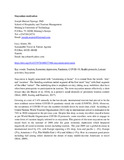Staycation motivation
Abstract
Staycation is largely associated with “vacationing at home”. It is coined from the words: ‘stay’ and ‘vacation’. The blending combines initial segment of the first word “stay” with final segment of the other “cation”. The underlying idea is emphasis on stay, taking away mobilities, that have often been prerequisite to participation in tourism. The term staycation means effectively a short leisure stay (de Bloom et al, 2016), in a person’s usual domicile or proximity tourism context (Molz, 2009; Jeuring and Haartsen, 2017).
Growing at a rate of 3-4% annually in the last decade, international tourism had proved to be the most resilient sector before COVID-19 pandemic struck the world (UNWTO, 2019). However, the occurrence of COVID-19 saw the numbers dwindle down by more than a half. According to United Nations World Tourism Organization (2021) dip in international arrival is estimated to be 74% in 2020 compared to the previous year. Despite this drop, as many travellers stayed at home as per World Health Organization COVID-19 protocols, some travellers were able to engage in some form of vacation largely referred to as staycation. The genesis of the term staycation can be traced back in the summer of 2008 after the great economic depression which impacted negatively all social economic sectors including tourism. The year 2009 saw a global decrease in international travel by 4%, with Europe reporting a 6% drop, Asia and pacific (– 2%), Europe (3%), Americas (−5%), The Middle East (−6%) and Africa (+5%). Rise in consumer good prices including fuel among others shattered the dream of many middle-income Americans to travel (Molz, 2009).
URI
https://www.elgaronline.com/view/nlm-book/9781800377479/b-9781800377486.staycation.motivation.xmlhttps://doi.org/10.4337/9781800377486.staycation.motivation
http://hdl.handle.net/123456789/5521

